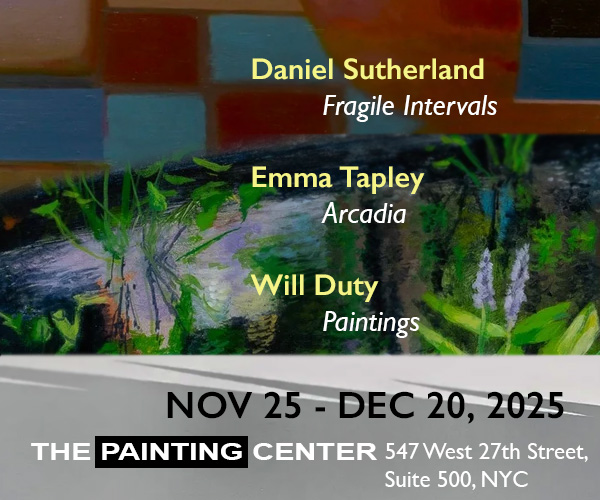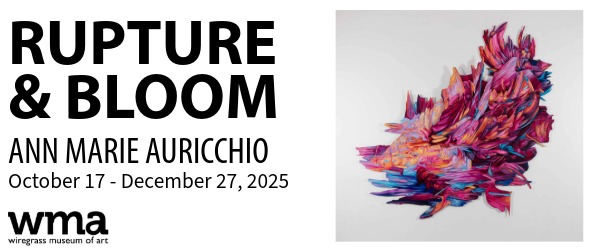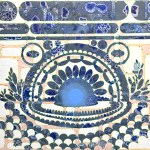Contributed by Vittorio Colaizzi / The first plate of Barnett Newman’s “Notes,” a series of etchings from 1968 that are on view at Craig Starr alongside drawings from Brice Marden’s Suicide Notes, contains an outlandish concentration of marks in the lower left of the central column. With this plate, as with his painting Achilles (1952), it seems as if he was pushing the limit of his own format, to see how much incident he could include without, in Donald Judd’s terminology, “weakening” the composition.
In Note III and Note VII, there is no such rude blot, but the crosshatching and pock-marking becomes so expansive that the marks acquire identity as things. Newman”s inexperience at the time with etching is not a cause to discount them — quite the opposite, because confronted with less than total assurance, Newman resorted to what art historian Richard Shiff called “material desire” and what he explained, with regard to some early drawings, as “how it went, that’s how it was.” He fell back on the intuition that he claimed was always close at hand.

Gabriele Schor characterizes the insistently identifiable figure-quality of the marks as an engagement with geometry and a parallel attempt, along with his series Who’s Afraid of Red, Yellow, and Blue? (1967-70), to present these visual elements — whether primary colors or shapes — for examination free of the attendant dogmas of idealism that had become associated with them. No less dogmatic than utopian geometry is the ban on compositional incident that came with minimalism, and while Newman’s art seems to prefigure and authorize this position, he also carefully resisted it.
Some years before these etchings, Newman had instigated a similar breakup of the field into numerous figures with a series of brush-and-ink drawings in 1960, at the same time that the Stations of the Cross (1958-66) series of paintings was materializing. In her invaluable study of Newman’s drawings, Brenda Richardson characterizes the most gestural of the 1960 drawings as “a consistent effort to treat the white of the paper as a neutral ground rather than as a second color,” but goes on to claim that they succeed in “energizing a neutral field with a single color (precisely the formal achievement of the Stations).” Newman also used bare canvas as a color in his contemporaneous Stations, asking himself, “[C]could I use the raw canvas the way I use a colored canvas to make that canvas come into some kind of color, so it would have some sense of light. . . . Could I get that large area to have what I would call the living quality of color without the use of color?” In the First Station (1958), Newman achieved this by alternating bare canvas with selectively tactile brushwork, in much the same way that he executed his drawings and etchings of two and ten years later. As Richardson implies, Newman set up the white as a neutral just so he could energize it within and between the inked areas, so that the brush-marks would shift from field to figure and back. The fullness of the field, interpenetrated by the white of the paper, depends upon a reading of its constituents as painted things, as gestural assertions. What Newman calls the fullness of color without actual color comes from this figure-ization of the ground, this bringing-forth of space, which he achieved in the drawings with slaps of the ink-laden brush, heading off the danger of “beguiling aesthetics” not this time, through steadfast restraint, but through emphatic excess.
Judd “object[ed] to. . . the brushwork and the airiness” of some of Newman’s paintings of the 1950s, preferring “the late ones,” which he saw as “very very flat.” Much less egregious than the “illusionistic space” of Cathedra (1951) were the stark black strokes around a masking-tape stencil on the right side of Shining Forth (To George) (1961). Here, according to Judd, the brushwork was “used as the nature of the edge, the process of making the edge,” as opposed to “making space.” Judd appreciated the frank materiality of this effect, finding it justifiable simply because “that is the way the paint was applied.” He also noted of Shining Forth that “The marks along the white stripe are even more intimately on the canvas than the black stripes.” The striking phrase, ?”even more intimately on,” privileges perception over physical constitution, admitting a space that only partially coincides with the literal.
Newman acknowledged to David Sylvester the “sense of an atmospheric background” in his early paintings, but excepted “a painting. . . called Euclidean Abyss [1946-47], where the background is black and has some of the white coming through, but there’s no true atmosphere.” Instead of atmosphere, the black marks seem to declare the surface as a place of encounter between painted marks and their absence, and are more intimately on the surface than if they were either thin washes or crisp shapes. Although Newman included Euclidean Abyss in the exhibition “The Ideographic Picture” in 1947, it may have gained even greater significance for him as one of the few, perhaps the only pre-Onement painting that so declared the surface, for it was after a similar marking-up, also visible in Treble (1960), and The Station (1963), that Newman re-energized himself after a drop-off in productivity, leading to a final period of vibrant colors. With Onement I, Newman left behind the textured paintings of the 40s in favor of more solid colors, which conveyed the unity he had been achieving with painterly drawings. Similarly, the mottled brushwork of the 1960 drawings precipitated the solid colors of the rest of the decade. The intensity and feeling of color found its graphic expression in ink drawings, while the activity of the ink had its analogue in the sealed and saturated colors of his late paintings. They are different ways of achieving what he called “the living quality of color.”
Euclidean Abyss consists not only of a textured surface, but also a composition, one that he tried out in other paintings and drawings, wherein a beam, bent ninety degrees, defines an eccentric and therefore assertive negative space in cooperation with a nearby column that, rather than bending, makes two curving turns. The bent beam?s coincidence with the edge was most notable for Newman:
[W]here I move to the edge, the edge has a yellow edge with a corner in it. For me, it?s a historic painting in terms of my own history, because there for the first time I moved to the edge, and the edge becomes lighter than the central section. Ostensibly it should have ended where the dark part ends, but I moved further to the actual edge of the canvas, and I felt that I?d moved to the edge but hadn’t fallen off.
It is not immediately clear what it would have meant to fall off the edge. Newman frequently described his process and aims in language other than the empirical and pragmatic, as when he claimed that the expanse of turquoise in Uriel was an attempt to “see how far [he] could stretch [the color] before it broke.” A successful stretching would preserve a tension and coherence, retaining the painting’s color in the sense that Newman used the term: “a scintillating wall of colors can be full of colors but have no color.”
Color stretched too far and broken into colors would result in an eccentric object that gives precedence to format, which Newman famously sought to suppress, again within the adverse conditions of working on triangular canvases with Jericho (1968-69) and Chartres (1969). Euclidean Abyss was an act of composition, as much as the block of red between two whites of White and Hot (1967) whose carefully intuited proportions and curiously excessive right side frame and thrust forward the area of color. To fall off the edge would have been to create an object, rather than to preserve it as an incidence of “human scale,” wherein the factuality of the surface attests to the human presence that was his content.
Newman reported feeling anxious in the 1940s, plagued not only by the question “What are we going to paint?” but also by the inadequacy of extant possibilities in the face of the worldwide trauma he saw. It is easy to scoff at his grandiose claim that “[I]f my work were properly understood, it would be the end of all state capitalism and totalitarianism.” However, it is a mistake to forget his “if” and congratulate ourselves for a more sober outlook. Paintings alone may not combat abuse and oppression, but consciousness is an important step, and Newman arranged form and scale (although not “objects,” “spaces,” or “graphic elements”) in order that one would be able to recognize the wholeness, separateness, and value of others and oneself in inter-relation. Through their wholeness, his paintings, drawings, and etching do not simply become objects, but are always almost objects, always pointing towards this possibility, and Newman models this towards-ness, rather than a definitive and marketable category. Newman’s legacy, if not his “influence,” can therefore expand beyond the foreclosure of pictorial invention to include a host of contemporary abstract painters who remain poised on the brink of definitions, and who do not concede that the explicit is better than the suggested. This poise can no longer be regarded as a failure of nerve.
“Newman: Notes ? Marden: Suicide Notes,” Craig Starr Gallery, 5 East 73rd Street, UES, New York, NY. Through April 16, 2022.
About the author: Vittorio Colaizzi holds an MFA in painting and a PhD in art history from VCU. He has held solo shows at the Eric Schindler Gallery in Richmond and Stump Town Gallery in Alma, Wisconsin, and he received a Virginia Museum of Fine Arts Professional Fellowship in 2006. His monograph on Robert Ryman was published by Phaidon in 2017, and he has also published essays on Trudy Benson, Joan Thorne, and Thornton Willis. Colaizzi is an associate professor of art history at Old Dominion University. Follow him on Instagram at @vcolaiz.
NOTES:
1 Judd, “Local History,” in Complete Writings: 1959-1975 (Halifax: The Press of the Nova Scotia College of Art and Design; New York: New York University Press, 1975), 151.
2 See Shiff, Doubt, (London: Routledge, 2008), 68, and for “intuition,” see Interview with Dorothy Gees Seckler, in John P. O’Neill, ed., Barnett Newman: Selected Writings and Interviews, (Berkeley, Los Angeles: University of California Press, 1992), 248. Hereafter SWI.
3 Gabriel Schor, “Art as Passion,” in The Prints of Barnett Newman: 1961-1969 (Stuttgart: Staatsgalerie; Verlag Gerd Hatje, 1996), 29-30.
4 Brenda Richardson, Barnett Newman: The Complete Drawings, 1944-1969 (Baltimore; The Baltimore Museum of Art, 1979), 190.
5 “A Conversation: Barnett Newman and Thomas B. Hess,” SWI, 277.
6 Judd in Jeanne Siegel, “Around Barnett Newman,” Art News vol. 70, no. 6 (October 1971): 59-60.
7 Don[ald] Judd, “Barnett Newman,” Studio International 179 (February 1970): 69.
8 Ibid, 68.
9 Georges Didi-Huberman also combines the literal and the metaphorical when he describes a “rush of air” in the reserved space of removed tape in the ink drawing Untitled (Onement) of 1947. This, along with the “fraying” brushwork creates, according to Didi-Huberman, a “respiration” to which he attributes the possibility of the operation, or “supposition,” of Walter Benjamin’s “aura.” Georges Didi-Huberman, “The Supposition of the Aura: The Now, The Then, and Modernity,” in Richard Francis, et al., Negotiating Rapture: The Power of Art to Transform Lives (Chicago: Museum of Contemporary Art, 1996), 59, 60 et passim.
10 Interview with David Sylvester, SWI, 255.
11 As highlighted in Bradford A. Epley, Michelle White, and Sarah K. Rich, Barnett Newman: The Late Work, 1965-1970 (Houston: The Menil Collection; New Haven and London: Yale University Press, 2015).
12 Interview with David Sylvester, SWI, 255.
13 Quoted by Harold Cohen, Barnett Newman Foundation, in Shiff, Doubt, 45.
14 Interview with Seckler, SWI, 249, emphasis in original.
15 A paraphrase of Newman’s famous assertion: “Size doesn’t count. It’s scale that counts. It’s human scale that counts. And the only way you can achieve human scale is by content.” To di Antonio, SWI, 307.
16 To de Antonio, SWI, 303.
17 Ibid., 307-08.
18 A paraphrase of Newman’s comments to Sylvester, SWI, 257-58. As to “arrangements;” Here I split a hair over Newman’s terminology, because after his claim about ending capitalism, he continued: “Because to the extent that my painting was not an arrangement of objects, not an arrangement of spaces, not an arrangement of graphic elements, was an open painting, in the sense that it represented an open world — to that extent I thought, and I still believe, that my work in terms of its social impact does denote the possibility of an open society, of an open world, not of a closed, institutional world.” SWI, 308. The variety within many of Newman’s works show that this open-ness was never given, only achieved.
Related posts:
Abstract Expressionist New York: Line and legacy
Stephen S. Pace: An Abstract Expressionist who moved beyond the brand






















